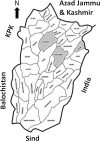Diversity of flora used for the cure of equine diseases in selected peri-urban areas of Punjab, Pakistan
- PMID: 24283263
- PMCID: PMC3851199
- DOI: 10.1186/1746-4269-9-70
Diversity of flora used for the cure of equine diseases in selected peri-urban areas of Punjab, Pakistan
Abstract
Background: Plants have widely been used and documented for their therapeutic potential in many parts of the world. There are, however, few reports on the use of plants for the treatment of diseases of equines. To this end, participatory epidemiology and rapid rural appraisal techniques were used to document the plants having pharmacotherapeutic significance against different ailments of equines in selected population of Punjab, Pakistan.
Methods: A survey was conducted to interview a total of 450 respondents (150 from each of the districts of Faisalabad, Lahore and Sargodha of Pakistan) to collect information about disease recognition of the equines and their treatment on a well - structured questionnaire. A total of 60 plants belonging to 40 families were documented. An inventory was developed depicting detailed information of plants used in treatment of different conditions of equines.
Results: The top ten species of plants used were: Allium cepa, Zingiber officinale, Vernonia anthelmintica, Capsicum annum, Brassica campestris, Trachyspermum ammi, Anethum graveolens, Picrorhiza kurroa, Azadirachta indica, and Citrullus colocynthis. Seeds were the most frequently used (n = 16/60) parts, followed by leaves (n = 12/60) and fruits (n = 11/60) of plants. Based on the combination of different parts of plants used in different ratios and variation in their dose or mode of preparation led to a large number of recipes/remedies against wounds, lameness, bronchitis, colic, anorexia, dermatitis, weakness, parasitism (internal and external), fever, heat stress, urine retention, swelling, toxemia, and indigestion.
Conclusions: This study generated lot of data on phytomedicinal approach for the treatment of ailments in the equines in some selected areas. It would, therefore, be imperative to expand similar studies in other parts of Pakistan and elsewhere. Moreover, use of the documented plants may be validated employing standard scientific procedures, which may have their application in the drug discovery/development by the pharmaceutical industry.
Figures
Similar articles
-
An account of the botanical anthelmintics used in traditional veterinary practices in Sahiwal district of Punjab, Pakistan.J Ethnopharmacol. 2008 Sep 2;119(1):185-90. doi: 10.1016/j.jep.2008.06.034. Epub 2008 Jul 9. J Ethnopharmacol. 2008. PMID: 18657602
-
An inventory of the ethnobotanicals used as anthelmintics in the southern Punjab (Pakistan).J Ethnopharmacol. 2006 Nov 3;108(1):152-4. doi: 10.1016/j.jep.2006.04.015. Epub 2006 Apr 29. J Ethnopharmacol. 2006. PMID: 16730420
-
Traditional uses of medicinal plants practiced by the indigenous communities at Mohmand Agency, FATA, Pakistan.J Ethnobiol Ethnomed. 2018 Jan 9;14(1):2. doi: 10.1186/s13002-017-0204-5. J Ethnobiol Ethnomed. 2018. PMID: 29316948 Free PMC article.
-
Treatment of malaria and related symptoms using traditional herbal medicine in Ethiopia.J Ethnopharmacol. 2018 Mar 1;213:262-279. doi: 10.1016/j.jep.2017.10.034. Epub 2017 Nov 2. J Ethnopharmacol. 2018. PMID: 29102764 Review.
-
Ethnoveterinary plants of Pakistan: a review.J Ethnobiol Ethnomed. 2020 May 15;16(1):25. doi: 10.1186/s13002-020-00369-1. J Ethnobiol Ethnomed. 2020. PMID: 32414421 Free PMC article. Review.
Cited by
-
Citrullus colocynthis (L.) Schrad.: A Promising Pharmaceutical Resource for Multiple Diseases.Molecules. 2023 Aug 24;28(17):6221. doi: 10.3390/molecules28176221. Molecules. 2023. PMID: 37687049 Free PMC article. Review.
-
Traditional medicinal plants used for respiratory disorders in Pakistan: a review of the ethno-medicinal and pharmacological evidence.Chin Med. 2018 Sep 18;13:48. doi: 10.1186/s13020-018-0204-y. eCollection 2018. Chin Med. 2018. PMID: 30250499 Free PMC article. Review.
-
Ethno-medicinal survey of important plants practiced by indigenous community at Ladha subdivision, South Waziristan agency, Pakistan.J Ethnobiol Ethnomed. 2016 Nov 15;12(1):53. doi: 10.1186/s13002-016-0126-7. J Ethnobiol Ethnomed. 2016. PMID: 27846856 Free PMC article.
-
Traditional knowledge about plant, animal, and mineral-based remedies to treat cattle, pigs, horses, and other domestic animals in the Mediterranean island of Sardinia.J Ethnobiol Ethnomed. 2018 Jul 20;14(1):50. doi: 10.1186/s13002-018-0250-7. J Ethnobiol Ethnomed. 2018. PMID: 30029686 Free PMC article.
References
-
- Urquhart GM, Armour J, Duncan JL, Dunn AM, Jennings FW. Veterinary Parasitology. 2. UK: Blackwell Science; 2007.
-
- Goraya K, Iqbal Z, Sajid MS, Muhammad G. Frequency distribution of equine diseases in three metropolises of the upper Punjab, Pakistan. Int J Agric Biol. 2013;00:000–000.
-
- Ole−Miaron JO. Ethnoveterinary practices of the Loitokitock Maasai: impact on the environment. Vet J. 1997;17:159–167.
Publication types
MeSH terms
LinkOut - more resources
Full Text Sources
Other Literature Sources
Medical


